Amazon isn’t just a store. It’s a search engine, and one that millions of people use every single day to find what they want and decide what to buy.
More than half of all product searches now begin on Amazon, making ranking in Amazon results just as important as showing up on Google.
If you’re selling physical products, you can’t rely on ads or hope someone stumbles across your listing. You need a plan that puts your product in front of buyers, right when they’re ready to buy.
This guide will show you exactly how to optimize for Amazon’s algorithm, improve your rankings, and turn your listings into search-driven assets that actually convert.
How does your website score? Get a free instant audit that will uncover the biggest SEO issues affecting your site, and how to fix them.
Article Summary
- Amazon is a product-focused search engine that requires its own SEO strategy.
- Ranking depends on both relevance (keywords) and performance (conversions, reviews).
- Keyword placement in titles, bullets, and backend fields is critical.
- Conversion-focused content and visuals boost search performance.
- Amazon SEO is essential for brand visibility in modern, multi-channel commerce.
Why Amazon SEO Matters in the Search-Everywhere Era
Before we go deeper, let’s clarify something, what is Amazon SEO? It’s the process of optimizing your product listings to rank higher in Amazon’s search results, just like traditional SEO does for websites.
But instead of backlinks and blog content, Amazon SEO optimization focuses on product titles, keyword fields, conversion signals, and performance data.
So why is it important?
When people want to buy something online, most of them don’t start on Google. They start on Amazon.
As of Q2 2023, 57% of U.S. consumers began their product searches on Amazon, compared to just 42% who started on a search engine.
A separate study by PowerReviews backs this up, showing that half of all shoppers go to Amazon first, while only 31% begin with Google.
Amazon is now the primary destination for product discovery, especially in the U.S., where 66% of shoppers check Amazon before any other source.
And it’s not just reach. It’s trust. Shoppers believe Amazon gives them accurate results, competitive pricing, and fast answers, which makes it the go-to channel for comparison and purchase.
Even though Amazon’s lead has narrowed slightly, dropping from 63% to 56% between Q1 2022 and Q1 2023, it still dominates first-touch search, far ahead of any other platform.
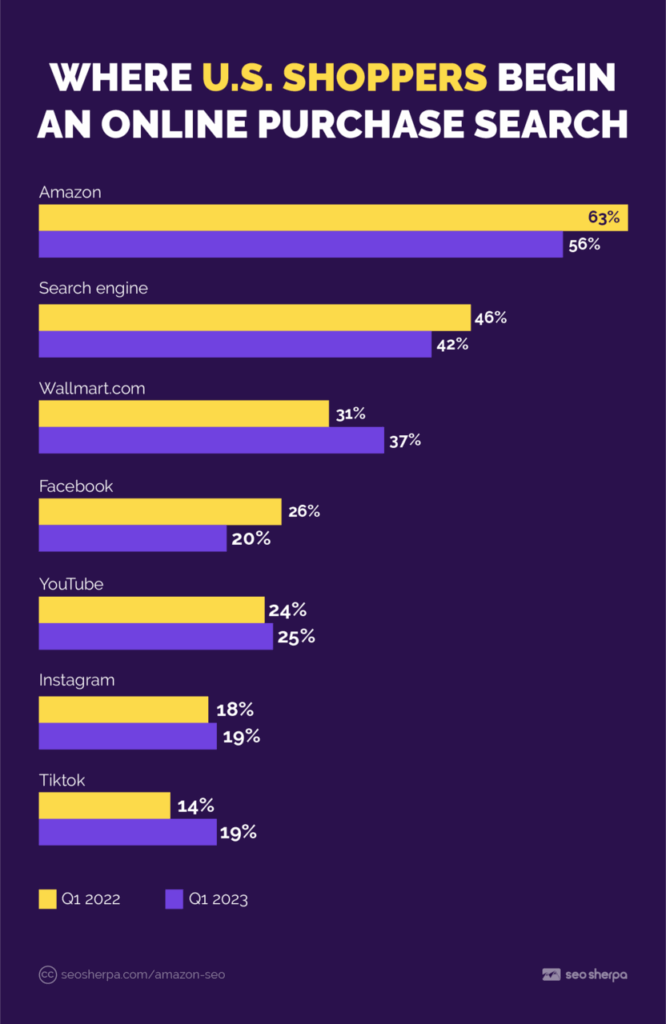
That small dip reflects younger shoppers using platforms like TikTok and Instagram for discovery.
But even with that shift, Amazon captures far more purchase-intent traffic than any other search engine.
This is exactly why Amazon SEO is non-negotiable in 2025.
Your product listings aren’t just ecommerce pages. They are search results.
And if your listings don’t appear when people type queries into the Amazon search box, you’re invisible at the moment buyers are ready to act.
At SEO Sherpa, this is what we mean by Search Everywhere Optimization.
We believe your brand should be discoverable across every platform where people search, not just on Google, but on Amazon, YouTube, TikTok, Reddit, and LinkedIn. Because the modern search journey doesn’t follow a single path. It happens everywhere.
Free Resource: The Complete Guide to Search Everywhere™ Optimization
Want to rank on Amazon and other platforms like Google, LinkedIn, or YouTube?
Check out our full guide:
The Complete Guide to Search Everywhere Optimization
It’s packed with actionable SEO tactics for dominating across multiple platforms.
Read the full guide and turn your listings into high-ranking, high-converting assets.
Understanding Amazon’s A9 and A10 Search Algorithms
Amazon’s algorithm has changed; quietly, but significantly.
For years, Amazon’s core ranking system was known as A9.
Many sellers still ask, how does Amazon’s A9 algorithm work?
It prioritized exact keyword matches and sales velocity, assuming that the best-selling, most keyword-loaded listings were also the most relevant.
This approach shaped early Amazon SEO. Sellers focused on cramming keywords into product titles and driving short-term sales through aggressive promotions. And for a while, it worked.
But around 2020–2021, Amazon began adjusting its algorithm behind the scenes. While the company never formally introduced a new system, sellers and analysts started calling the evolved model A10. It reflects a broader shift toward user behavior and listing quality, not just keyword use.
Let’s break down key factors that influence Amazon SEO today:
Key Ranking Factors in Amazon SEO (A10 Algorithm)
Keyword Relevance and SEO Optimization
You still need to include relevant keywords in your title, bullet points, product description, and backend fields. That’s the baseline for Amazon SEO. But it’s not about keyword stuffing. The algorithm now prioritizes context and intent.
Click-Through Rate (CTR)
Your click-through rate (CTR) also matters.
CTR shows how often shoppers click on your listing when it appears in search. A strong title, clean main image, competitive price, and solid review count are all factors that boost CTR. Amazon’s Search Query Performance reports now include brand-level click rate data, which reflects how critical CTR has become.
About 35% of shoppers click the first result, and the top three listings capture nearly 64% of clicks. Ranking high gives you visibility, but you need to hold that spot with an attractive listing.
Conversion Rate and Sales Velocity
After the click, Amazon looks at conversion rate (CVR).
Amazon ranks listings that consistently convert. That means your Unit Session Percentage—your conversion rate—is a direct ranking factor. It reflects how many people buy after viewing your product. Products that convert well climb higher in search.
In fact, A10 gives more weight to organic sales velocity than ad-driven performance. If you go out of stock or conversions drop, expect your ranking to follow.
Seller Authority and Prime Eligibility
Who you are as a seller also matters.
Amazon wants listings from sellers who consistently deliver a good experience. That means your order defect rate, late shipment rate, and customer feedback score all factor into how Amazon ranks your products.
External Traffic and Off-Amazon
Amazon now watches how much traffic you bring in from outside the platform. If your product earns clicks from external channels, like social ads, SEO content, or influencer mentions, it’s a positive signal.
Amazon’s Brand Referral Bonus rewards this behavior, and sellers who drive conversions from platforms like Facebook or TikTok often see a ranking lift for related keywords. Pricing and Competitiveness
Pricing and Competitiveness
Amazon ranks products that are likely to sell. Price plays a big role in that. If your product is more expensive than similar options and doesn’t justify the premium, conversion suffers, and so does your rank.
A competitive pricing strategy improves sales velocity, which then improves rankings. During peak periods like holidays or product launches, even a slight discount can spike sales and boost search performance long term.
Reviews and Ratings
Reviews may not be called out in the A10 documentation, but they’re a core signal across the funnel. They impact CTR, conversion, and likely even ranking relevance.
Fresh reviews, review quality, and how you respond to feedback all matter. Poor customer experiences pull down your seller authority. Great experiences push your listing to the top.

This reviews section shows how Amazon surfaces star averages, buyer images, and detailed feedback, all signals the A10 algorithm uses to gauge product trust and rank listings accordingly
Each of these factors feeds the algorithm differently, but together they shape how your listing ranks. If you want to win the search results page, you need to align with all of them, at once.
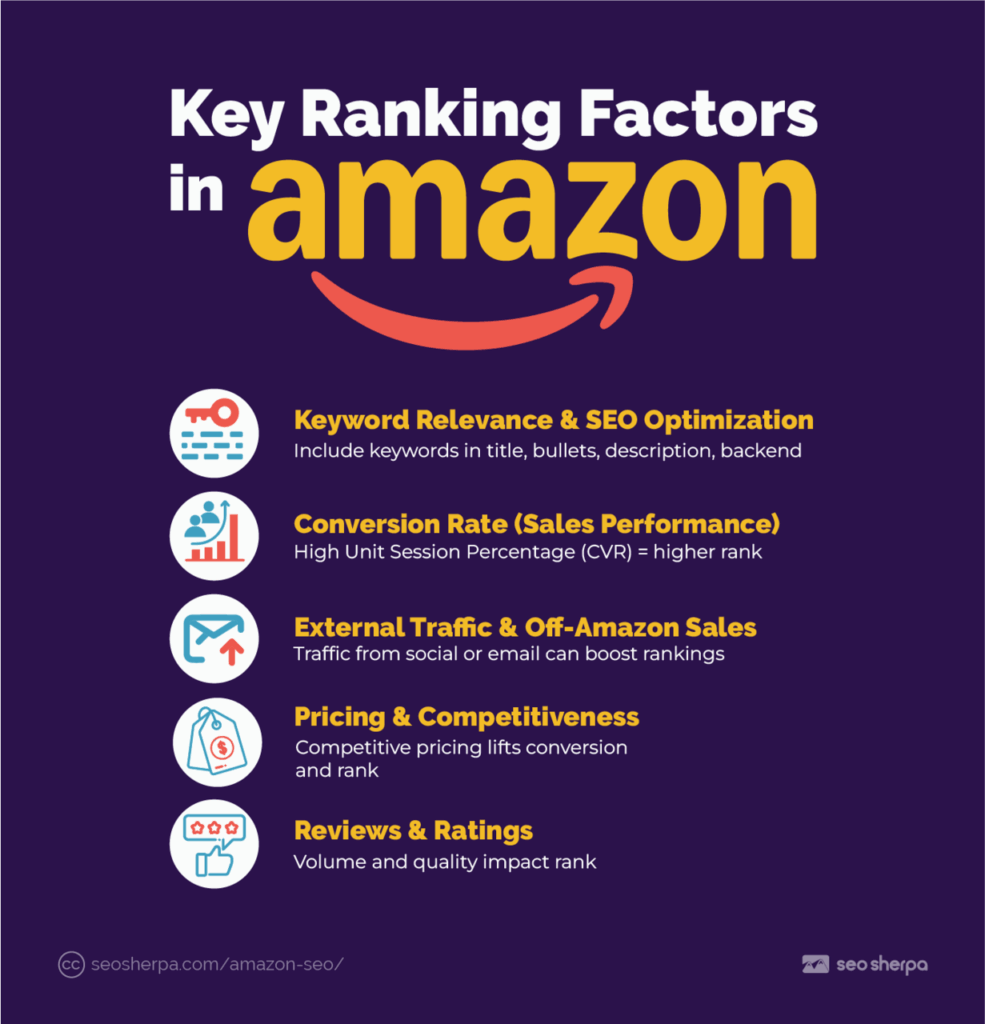
Where to Put Keywords in Amazon Listings?
Amazon SEO isn’t about keyword density. It’s about keyword placement, knowing exactly where to put high-intent search terms so your listing shows up when customers search.
If your keyword isn’t in your listing, Amazon won’t rank you for it. But where you include it can influence how strongly your product ranks for that search term.
Let’s walk through the most important areas.
The product title is your top-priority keyword field. It carries the most weight in Amazon’s search algorithm and is the first thing shoppers see.
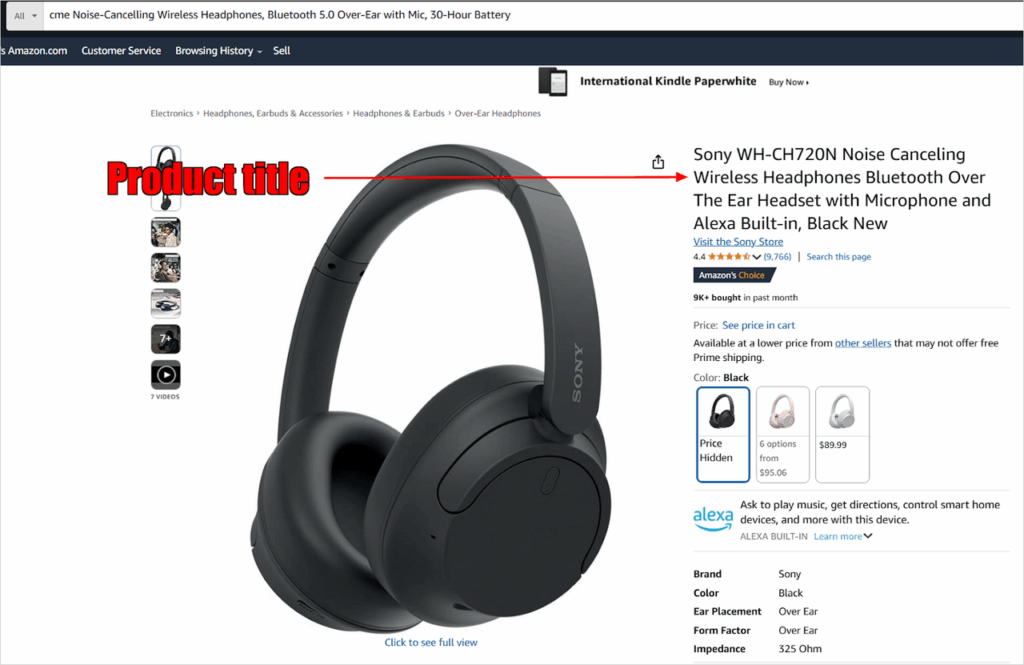
Most categories allow up to 200 characters, but the goal isn’t to max that out.
Put your main keyword near the beginning of the title. That helps both Amazon and the shopper immediately understand what your product is. Keep the format clean and compliant with Amazon’s title guidelines.
Amazon’s algorithm can actually parse keywords even if they’re not adjacent, so you don’t need to repeat a word multiple times.
A title like:
“Acme Noise-Cancelling Wireless Headphones, Bluetooth 5.0 Over-Ear with Mic, 30-Hour Battery”
hits multiple relevant keywords; Noise-Cancelling Headphones, Wireless Headphones, Bluetooth 5.0, Over-Ear Headphones, while staying readable.
Next up: bullet points. These are indexed and serve as your main product pitch. Each bullet should highlight a key feature or benefit, using supporting keywords that didn’t fit cleanly into the title. For example, if your title already includes “Travel Mug,” your bullets might incorporate “Coffee Thermos,” “Leakproof Lid,” or “Fits Cup Holders.”
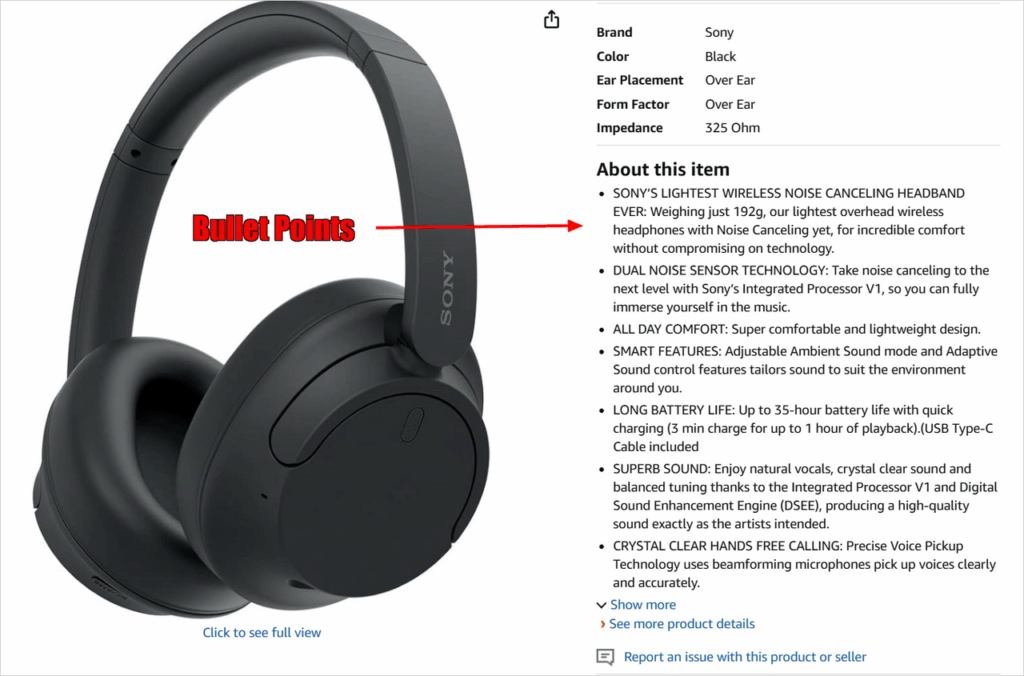
Start each bullet with a bolded benefit, followed by a short, clear explanation. Use variations, not repetitions. The bullets should be optimized for both visibility and persuasion.
Then there’s your product description (or A+ Content for brand-registered sellers). This is where you expand on your features and include long-tail keywords that customers might search for when comparing products. You can describe use cases, include your brand story, or answer specific buying questions.

This section shows A+ Content modules, headline image, feature blocks, and lifestyle shots, where hidden alt text can carry extra keywords for Amazon indexing.
Note: If you’re using A+ Content, remember that some modules may be indexed, including alt text on images. That gives you another opportunity to integrate keywords without cluttering the visible content.
Behind the scenes, Amazon gives a specific section in Seller Central to add additional keywords (sometimes called “generic keywords” or simply Search Terms).
This is hidden from customers but indexed by Amazon. In 2024, most categories allow at least 250 characters in the Search Terms field – some allow more or have multiple fields.
The key here is to use this space wisely.
Use this field to include:
- Synonyms and alternate spellings
- Common abbreviations
- Low-volume keywords that didn’t fit elsewhere
Don’t repeat words already used in your title or bullets. Use spaces between keywords (no commas), avoid brand names you don’t own, and stay within the character limit, typically 249 bytes.
For example, if your listing already mentions “coffee thermos,” you might add “coffee tumbler,” “spill proof cup,” or “hot drink container” to your backend field.
Taken together, these placements cover the full range of buyer intent, ensuring your product appears for a wider set of search terms.
But keywords alone don’t guarantee visibility. Amazon’s algorithm also looks at how your listing performs; how often it’s clicked, how well it converts, and how happy buyers are afterward.
That’s what we’ll cover next.
Optimizing for Click-Through and Conversion
Getting your listing to rank is only the first half of Amazon SEO. The second half is what happens next, whether people click, and whether they buy.
Amazon’s algorithm doesn’t just reward keyword relevance. It prioritizes products that get clicks and convert well. That means your click-through rate (CTR) and conversion rate (CVR) directly affect how visible your product stays in the search results.
Your main product image is the biggest driver of clicks. It’s the first thing a shopper sees, and it’s often what makes them stop scrolling. The image should be high-resolution, professionally lit, and follow Amazon’s image guidelines.
Amazon allows up to 7 to 9 images per listing (including the main image). Use as many of these slots as you can with high-quality photos. The main image should have a pure white background and clearly show the product (required), but you want it to stand out. One tip is to ensure your main image is zoomable (1000px or larger) and that it’s bright and eye-catching even as a small thumbnail.
For additional images, include lifestyle images and infographic images: show the product in use, show scale, highlight features or dimensions with text overlays (Amazon permits infographics on secondary images).
Optimize bullet points and product titles on Amazon. It should be easy to scan, clearly communicate the product, and highlight what matters most, whether that’s material, feature, or benefit. If your title looks cluttered or reads like keyword spam, shoppers will scroll past.
A proven format is: Brand + Key Product Descriptor + Main Features/Attributes + (if space) Model or Variant.
For example: “Anker Wireless Noise-Cancelling Bluetooth Headphones, 40H Playtime, Over-Ear, with Deep Bass and Mic”. This title hits brand, product type, and key features.
Notice it’s readable – avoid stuffing a comma-separated list of keywords that makes no sense to a human.
It should make a shopper want to click. Mention compelling attributes like “2024 New Model” or “Official Store” (if allowed) or a unique selling point if you have room.
Also, consider the 80/20 rule for titles: many devices will show only the first ~80 characters of a title before cutting off, so make sure the most important part of your title is front-loaded.
When it comes to improving conversions, your bullet points need to do more than list features. They should explain why those features matter. If you mention “Stainless Steel Construction,” explain the benefit “Prevents rust and keeps your mug odor-free.”
Then there’s price and fulfillment. Shoppers compare at a glance. If you’re priced well and have the Prime badge, you’ll likely win more clicks.
If you use Fulfilled by Amazon (FBA) or Seller-Fulfilled Prime, your listings often get a boost thanks to the Prime badge. Products with Prime eligibility get more exposure, and FBA listings often convert at 2–3x the industry average .
If you’re brand-registered, use A+ Content to boost conversions and differentiate from competitors.
EBC allows you to add:
- Custom modules (charts, images, feature comparisons)
- Visual storytelling elements
- Trust-building assets like certifications or guarantees
A+ Content can improve conversion rates significantly when it’s done right. Just remember that not all A+ text is indexed for SEO. Its strength is in helping shoppers understand and feel confident in your product.
Remember CTR gets shoppers to your page. CVR keeps your listing ranked.
Leveraging Reviews, Ratings, and Q&A for SEO
On Amazon, reviews aren’t just social proof. They’re ranking signals.
The number of reviews, the average star rating, and how customers talk about your product all feed into your search visibility. Products with stronger ratings and more reviews consistently rank higher, because Amazon’s algorithm sees them as safer bets for conversions.
Let’s start with the review volume. A product with 500 reviews and a 4.5-star average will outperform a product with 12 reviews and a similar rating. Amazon favors listings that have been validated by real customers over time. If you’re launching a new product, using programs like Amazon Vine (if you’re brand registered) can help generate your first batch of honest reviews quickly.
But it’s not just the numbers.
Review content matters too. Amazon’s system parses reviews for relevance. If customers consistently mention specific features—like “leakproof lid” or “fits cup holders”—those keywords can reinforce what your product ranks for. This is an overlooked advantage: your reviews can help you show up for more long-tail search queries without adding extra keywords to your listing.
Then there’s the Q&A section. When shoppers ask questions and you respond, that content becomes part of your listing. Amazon indexes this text, which means a well-written answer can help your product appear for related searches. You’re also solving objections in real time, which improves trust and can boost your conversion rate.
Responding to questions quickly also signals active engagement. If shoppers see that the brand answers questions and clarifies concerns, it builds credibility.
Want more keyword coverage? Use questions and answers to surface secondary phrases or common synonyms. If people ask, “Is this dishwasher safe?” and you answer using that exact language, you’re reinforcing that relevance for search.
To leverage reviews and Q&A for Amazon SEO:
- Encourage feedback post-purchase using Amazon’s “Request a Review” feature
- Monitor your Q&A section weekly to catch unanswered or outdated responses
- Reference relevant keywords naturally when replying to reviews or questions
- Fix the product if multiple reviews mention the same issue
Optimizing for reviews and engagement isn’t just about perception, it directly affects your search rankings, conversion rate, and long-term visibility.
Amazon SEO Tools and Resources
You don’t need to guess your way through Amazon SEO. The right tools can show you which keywords to target, how competitors are ranking, and what’s holding your listings back.
Let’s break down the platforms that matter most.
Helium 10 is the go-to platform for end-to-end listing optimization. It has tools like Cerebro to help you reverse-engineer competitor keywords, while Magnet surfaces high-volume terms in your niche.
You can use Frankenstein and Scribbles to clean up keyword lists and implement them, and Keyword Tracker to monitor your rankings over time. If you want one dashboard to handle SEO, PPC, inventory, and listing alerts, Helium 10 has it.
Jungle Scout is especially strong for product research and early-stage SEO. Keyword Scout helps estimate volume and competitiveness. Its tools such as Listing Builder integrates keywords in real time. Rank Tracker lets you see movement over time, and Opportunity Score shows how easy or difficult it is to break into a niche. The browser extension gives fast, on-page insights while browsing Amazon, making product validation much faster.
Amazon Brand Analytics is a must if you’re brand-registered. It gives you access to Search Query Performance, Market Basket Analysis, and Repeat Purchase Behavior, all built from Amazon’s own first-party data. This is the closest you’ll get to seeing how customers move through the marketplace.
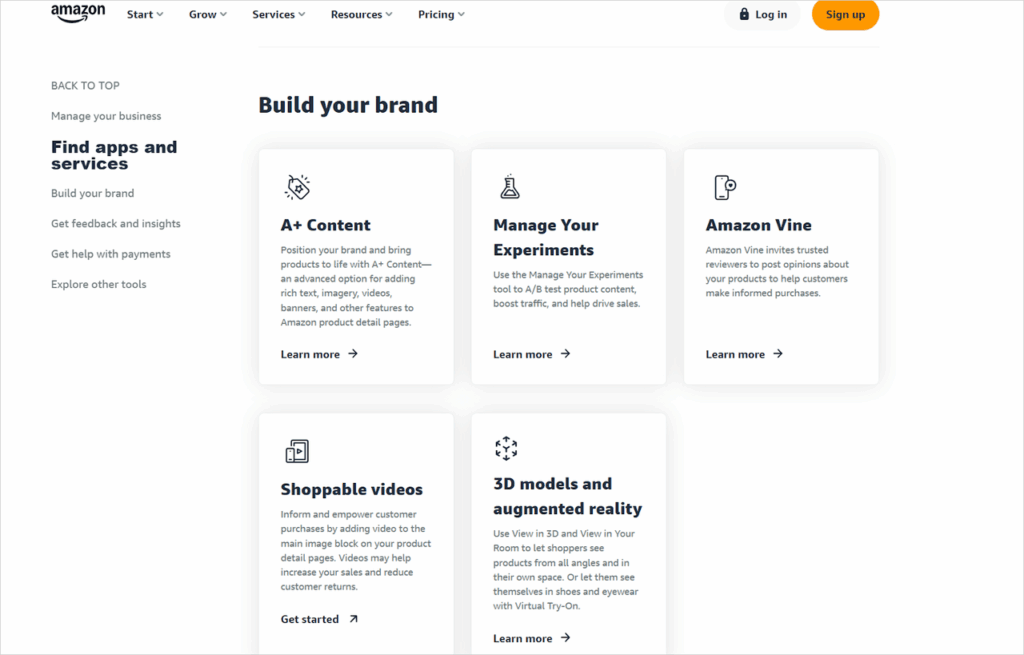
If you’re looking to improve what’s already working, Manage Your Experiments is a hidden gem. It allows A/B testing on product titles, images, and content. Run two versions of a listing, compare performance, and double down on what converts best.
Example: Test two titles
- Version A: “Stainless Steel Travel Mug – 16 oz, BPA-Free”
- Version B: “16 oz BPA-Free Stainless Steel Travel Mug, Leakproof Design”
After a few weeks, you’ll know which one sells more, and you can move on to test your main image next.
Other helpful tools include MerchantWords for quick keyword volume checks, AMZ One for listing support and photography, and Sellics for PPC and profitability tracking.
You don’t need to use them all. Start with what fits your workflow and scale from there. Whether you’re optimizing for one product or an entire catalog, your Amazon SEO strategy should be backed by data, and not guesswork.
Common Amazon SEO Mistakes to Avoid
Even experienced sellers miss the mark on Amazon SEO. And in a marketplace this competitive, small errors can tank your rankings.
Let’s walk through the mistakes that hurt visibility, and how to avoid them.
Keyword stuffing is one of the most common problems. Jamming every possible keyword into your title or bullets makes your listing hard to read and easy to ignore. Amazon doesn’t reward clutter. If your title looks like “BEST BPA-FREE STAINLESS STEEL TRAVEL MUG HOT COFFEE CUP INSULATED THERMOS 16OZ,” you’re doing too much. Clean structure wins.
Using irrelevant keywords is just as bad. Some sellers add high-volume terms hoping to grab more traffic, but if the keywords don’t match your product, your conversion rate drops. And when that happens, Amazon sees your listing as less relevant, because people are bouncing, not buying.
Ignoring backend keyword fields means you’re leaving valuable real estate empty. You might have great front-facing content, but if you skip the backend, you’re missing out on alternate spellings, synonyms, or long-tail terms that buyers are actually searching.
Never updating your listing is a silent killer. Trends shift. Search terms evolve. If your listing is the same as it was 12 months ago, chances are you’re missing better keyword opportunities, and your competitors are climbing ahead.
Poor images will cost you both clicks and conversions. If your main image is blurry, unprofessional, or doesn’t clearly show the product, shoppers won’t click. If your supporting images are weak, they won’t convert. Amazon’s algorithm is watching both.
Violating Amazon’s content guidelines will get you flagged. All-caps, misleading claims, or banned phrases like “FDA-approved” can lead to suppressed listings. Always follow Amazon’s category style guides and policies.
Overpricing without justification is another red flag. If your item costs more than similar listings but you’re not explaining why—through features, branding, or A+ content—you’ll struggle to convert. And Amazon rewards products that sell, not products that just sit.
Running out of stock can derail your ranking completely. Once your listing is unavailable, Amazon stops showing it. When you restock, your momentum is gone and you’re often starting from scratch.
Ignoring negative reviews creates a credibility gap. If buyers consistently flag the same issue and you do nothing to fix it—or even acknowledge it—your listing suffers. Smart brands respond, adjust, and show they’re listening.
Need Help With Your Amazon Strategy? Let’s Talk
If your listings aren’t converting, or if your products aren’t even showing up, let’s fix that.
Book a Free Discovery Call and we’ll show you what’s holding you back (and how we’ll help fix it).
It’s 100% free, and we’ll give you clear,SEO tips for Amazon sellers.
Own the Marketplace With Search-Everywhere SEO
Amazon isn’t just a sales channel. It’s a search engine, and it’s where buyers go first when they’re ready to purchase.
If your product isn’t showing up on search rankings, you’re not in the conversation.
That’s why Amazon SEO matters. When you start optimizing bullet points and product titles on Amazon, backend fields, and imagery, you’re not just improving visibility. You’re building a listing that earns clicks, converts traffic, and keeps climbing.
And when you combine that with a broader Search Everywhere Optimization strategy, you’re not just winning on Amazon. You’re showing up across Google, YouTube, TikTok, LinkedIn, and every platform where your customers search.
That’s how brands win now.
So don’t stop at Google. Don’t settle for decent. Build listings that dominate, and make Amazon work like the search engine it actually is.


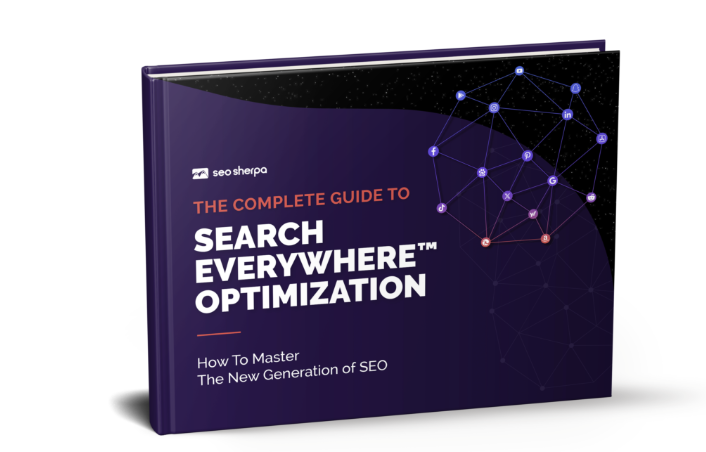











Leave a Reply